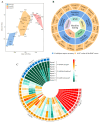The Ability of Different Tea Tree Germplasm Resources in South China to Aggregate Rhizosphere Soil Characteristic Fungi Affects Tea Quality
- PMID: 39124147
- PMCID: PMC11314174
- DOI: 10.3390/plants13152029
The Ability of Different Tea Tree Germplasm Resources in South China to Aggregate Rhizosphere Soil Characteristic Fungi Affects Tea Quality
Abstract
It is generally recognized that the quality differences in plant germplasm resources are genetically determined, and that only a good "pedigree" can have good quality. Ecological memory of plants and rhizosphere soil fungi provides a new perspective to understand this phenomenon. Here, we selected 45 tea tree germplasm resources and analyzed the rhizosphere soil fungi, nutrient content and tea quality. We found that the ecological memory of tea trees for soil fungi led to the recruitment and aggregation of dominant fungal populations that were similar across tea tree varieties, differing only in the number of fungi. We performed continuous simulation and validation to identify four characteristic fungal genera that determined the quality differences. Further analysis showed that the greater the recruitment and aggregation of Saitozyma and Archaeorhizomyces by tea trees, the greater the rejection of Chaetomium and Trechispora, the higher the available nutrient content in the soil and the better the tea quality. In summary, our study presents a new perspective, showing that ecological memory between tea trees and rhizosphere soil fungi leads to differences in plants' ability to recruit and aggregate characteristic fungi, which is one of the most important determinants of tea quality. The artificial inoculation of rhizosphere fungi may reconstruct the ecological memory of tea trees and substantially improve their quality.
Keywords: Camellia sinensis; deep machine learning; ecological memory; nutrient transformation; quality.
Conflict of interest statement
The authors declare no conflicts of interest.
Figures








References
-
- Galviz Y.C., Ribeiro R.V., Souza G.M. Yes, plants do have memory. Theor. Exp. Plant Phys. 2020;32:195–202. doi: 10.1007/s40626-020-00181-y. - DOI
-
- Padisak J. Seasonal succession of phytoplankton in a large shallow lake (Balaton, Hungary)—A dynamic approach to ecological memory, its possible role and mechanisms. J. Ecol. 1992;80:217–230. doi: 10.2307/2261008. - DOI
Grants and funding
LinkOut - more resources
Full Text Sources

